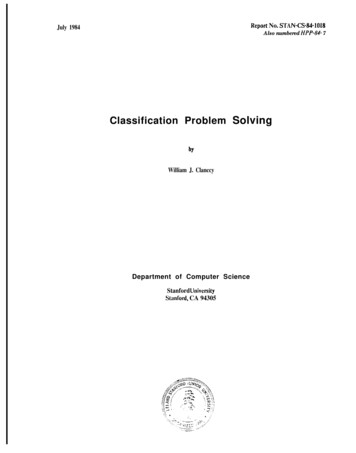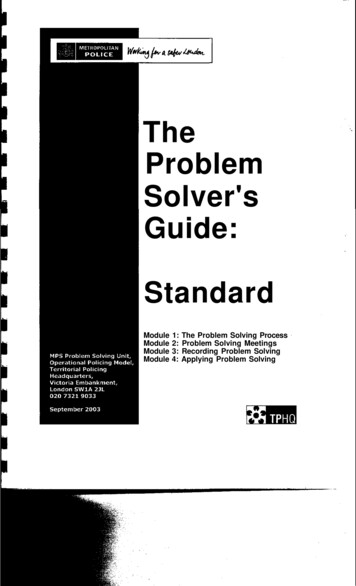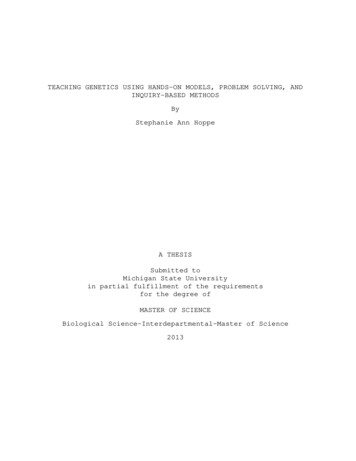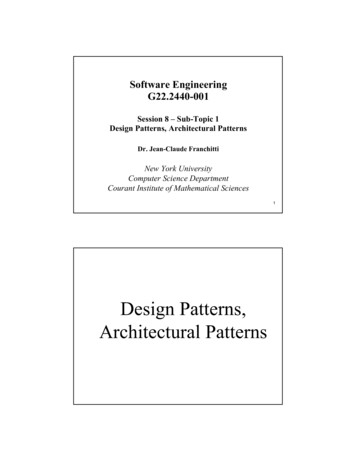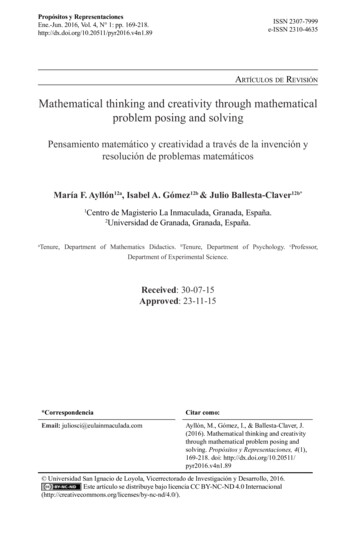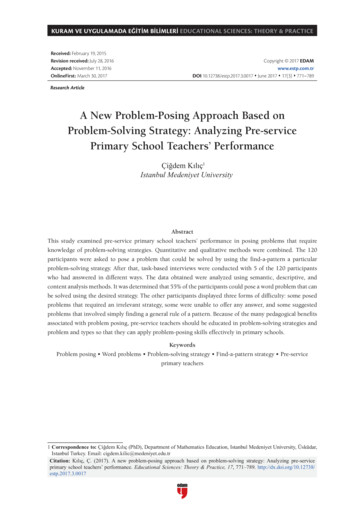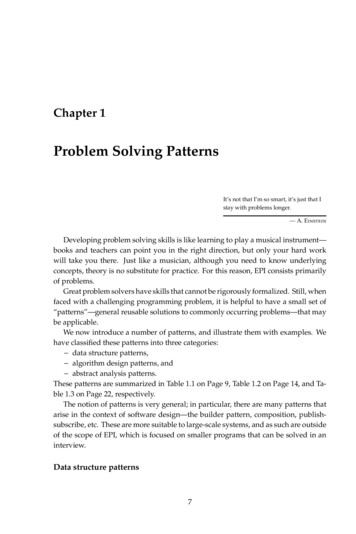
Transcription
Chapter 1Problem Solving PatternsIt’s not that I’m so smart, it’s just that Istay with problems longer.— A. EinsteinDeveloping problem solving skills is like learning to play a musical instrument—books and teachers can point you in the right direction, but only your hard workwill take you there. Just like a musician, although you need to know underlyingconcepts, theory is no substitute for practice. For this reason, EPI consists primarilyof problems.Great problem solvers have skills that cannot be rigorously formalized. Still, whenfaced with a challenging programming problem, it is helpful to have a small set of“patterns”—general reusable solutions to commonly occurring problems—that maybe applicable.We now introduce a number of patterns, and illustrate them with examples. Wehave classified these patterns into three categories: data structure patterns, algorithm design patterns, and abstract analysis patterns.These patterns are summarized in Table 1.1 on Page 9, Table 1.2 on Page 14, and Table 1.3 on Page 22, respectively.The notion of patterns is very general; in particular, there are many patterns thatarise in the context of software design—the builder pattern, composition, publishsubscribe, etc. These are more suitable to large-scale systems, and as such are outsideof the scope of EPI, which is focused on smaller programs that can be solved in aninterview.Data structure patterns7
8v963 http://bit.ly/epireviewsChapter 1. Problem Solving PatternsA data structure is a particular way of storing and organizing related data itemsso that they can be manipulated efficiently. Usually, the correct selection of datastructures is key to designing a good algorithm. Different data structures are suitedto different of applications; some are highly specialized. For example, heaps areparticularly well-suited for algorithms that merge different sorted data streams, whilecompiler implementations usually use hash tables to look up identifiers.A solution will often require a combination of data structures. For example, oursolution to the problem of tracking the most visited pages on a website (Solution 9.12on Page 82) involves a combination of a heap, a queue, a BST, and a hash table.Primitive typesYou should be comfortable with the basic types (chars, integers, doubles, etc.), theirvariants (unsigned, long, etc.), and operations on them (bitwise operators, comparison, etc.). Don’t forget that the basic types differ between programming languages.For example, there are no unsigned integers in Java, and the number of bits in aninteger is compiler- and machine-dependent in C.A common problem related to basic types is computing the number of bits setto 1 in an integer-valued variable x. To solve this problem, you need to know howto manipulate individual bits in an integer. One straightforward approach is toiteratively test individual bits, using an unsigned integer variable m initialized to 1.Iteratively identify bits of x that are set to 1 by examining the bitwise AND of m withx, shifting m left by one bit at a time. The overall complexity is O(n) where n is thelength of the integer.Another approach, that may run faster on some inputs, is based on computingy x&(x 1), where & is the bitwise AND operator. This is 1 at exactly the rightmostbit of x. Consequently, this bit can be removed from x by computing x y. The timecomplexity is O(s), where s is the number of bits set to 1 in x.In practice, if the computation is performed repeatedly, the most efficient approachwould be to create a lookup table. For example, we could use a 256 entry integervalued array P such that P[i] is the number of bits set to 1 in i. If x is 32 bits, the resultcan be computed by decomposing x into 4 disjoint bytes, b3, b2, b1, and b0. The bytesare computed using bitmasks and shifting, e.g., b1 is (x & 0xff00) » 8. The finalresult is P[b3] P[b2] P[b1] P[b0]. Computing the parity of an integer is closelyrelated to counting the number of bits set to 1, and we present a detailed analysis ofthe parity problem in Solution 2.1 on Page 171.ArraysConceptually, an array maps integers in the range [0, n 1] to objects of a giventype, where n is the number of objects in this array. Array lookup and insertion arevery fast, making arrays suitable for a variety of applications. Reading past the lastelement of an array is a common error, invariably with catastrophic consequences.
Chapter 1. Problem Solving Patternsv963 http://bit.ly/epireviewsTable 1.1: Data structure patterns.Data structurePrimitive typesArraysStringsListsStacks and queuesBinary treesHeapsHashesBSTsKey pointsKnow how int, char, double, etc. are represented inmemory and the primitive operations on them.Fast access for element at an index, slow lookups (unless sorted) and insertions. Be comfortable with notions of iteration, resizing, partitioning, merging, etc.Know how strings are represented in memory. Understand basic operators such as comparison, copying,matching, joining, splitting, etc.Understand trade-offs with respect to arrays. Be comfortable with iteration, insertion, and deletion withinsingly and doubly linked lists. Know how to implement a list with dynamic allocation, and with arrays.Understand insertion and deletion. Know array andlinked list implementations.Use for representing hierarchical data. Know aboutdepth, height, leaves, search path, traversal sequences,successor/predecessor operations.Key benefit: O(1) lookup find-min, O(log n) insertion,and O(log n) deletion of min. Node and array representations. Max-heap variant.Key benefit: O(1) insertions, deletions and lookups.Key disadvantages: not suitable for order-relatedqueries; need for resizing; poor worst case performance. Understand implementation using array ofbuckets and collision chains. Know hash functions forintegers, strings, objects. Understand importance ofequals function. Variants such as Bloom filters.Key benefit: O(log n) insertions, deletions, lookups,find-min, find-max, successor, predecessor when treeis balanced. Understand implementation using nodesand pointers. Be familiar with notion of balance, andoperations maintaining balance. Know how to augment a BST, e.g., interval trees and dynamic orderstatistics.9
10v963 http://bit.ly/epireviewsChapter 1. Problem Solving PatternsThe following problem arises when optimizing quicksort: given an array A whoseelements are comparable, and an index i, reorder the elements of A so that the initialelements are all less than A[i], and are followed by elements equal to A[i], which inturn are followed by elements greater than A[i], using O(1) space.The key to the solution is to maintain two regions on opposite sides of the arraythat meet the requirements, and grow these regions one element at a time. Detailsare given in Solution 3.1 on Page 181.StringsStrings are ubiquitous in programming today—scripting, web development, bioinformatics all make extensive use of strings. The following problem illustrates someof the intricacies of string manipulation.Suppose you are asked to write a function that takes as input a string s over theletters {“a”, “b”, “c”, “d”}, and replaces each “a” by “dd” and deletes each “b”.It is straightforward to implement such a function if it can allocate O( s ) additionalstorage. However, if you are allowed to use only O(1) additional storage, the problembecomes more challenging. It is given that s is stored in an array that has enoughspace for the final result.One approach is to make a first pass through s in which we delete each “b” andcount the number of “a”s. We then make a second pass working backwards from theend of the current string, copying characters to the end of the result string (whosesize we know from the number of “a”s), replacing each “a”, by “dd”. Details aregiven in Solution 3.10 on Page 189.ListsAn abstract data type (ADT) is a mathematical model for a class of data structuresthat have similar functionality. Strictly speaking, a list is an ADT, and not a datastructure. It implements an ordered collection of values, which may be repeated. Inthe context of this book, we view a list as a sequence of nodes with links to the nextnode in the sequence. In a doubly linked list each node additionally has links to theprior node.A list is similar to an array in that it contains objects in a linear order. The keydifference is that inserting and deleting elements has time complexity O(1); obtainingthe k-th element in a list is expensive, having O(n) time complexity. Lists are usuallybuilding blocks of more complex data structures. However, they can be the subjectof tricky problems in their own right, as illustrated by the following:Given a singly linked list hl0 , l1 , l2 , . . . , ln 1 i, assuming n is even, define the “zip” ofthe list to be hl0 , ln 1 , l1 , ln 2 , . . . , l n2 1 , l n2 i. Suppose you were asked to write a functionthat computes the zip of a list, with the constraint that it should not use any additionalstorage (either by explicit allocation on the heap, or via the program stack) beyond afew words.
11Chapter 1. Problem Solving Patternsv963 8300x21100x2200(a) List before zipping. The number in hex below each node represents its address in ) List after zipping. Note that nodes are reused—no memory has been allocated.Figure 1.1:The solution is based on an appropriate iteration combined with “pointer swapping”, i.e., updating next and previous fields for each node. Refer to Solution 4.11on Page 213 for details.Stacks and queuesStacks support last-in, first-out semantics for inserts and deletes, whereas queues arefirst-in, first-out. Both are ADTs, and are commonly implemented using linked listsor arrays. Like lists, they are usually building blocks in a more complex setting, butcan make for interesting problems in their own right.As an example, consider the problem of evaluating Reverse Polish notation expressions, i.e., expressions of the form “3, 4, , 1, 2, , ”, “1, 1, , 2, ”, or “4, 6, /, 2, /”.A stack is ideal for this purpose—operands are pushed on the stack, and popped asoperators are processed, with intermediate results being pushed back onto the stack.Details are given in Solution 5.2 on Page 216.Binary treesA binary tree is a data structure that can represent hierarchical relationships. Binarytrees most commonly occur in the context of binary search trees, wherein keys arestored in a sorted fashion. However, there are many other applications of binarytrees. For example, consider a set of resources organized as nodes in a binary tree.Processes need to be able to lock resource nodes. A node can be locked if and onlyif none of its descendants and ancestors are locked. Your task is to design andimplement an application programming interface (API) for locking.A reasonable API is one with isLock(), lock(), and unLock() methods. Naïvelyimplemented the time complexity for these methods is O(n), where n is the number ofnodes. However, these can be made to run in time O(1), O(h), and O(h) respectively,if nodes have a parent field. Details are given in Solution 6.4 on Page 231.HeapsA heap is a data structure based on a binary tree. It efficiently implements an ADTcalled a priority queue. A priority queue resembles a queue, with one difference:
12v963 http://bit.ly/epireviewsChapter 1. Problem Solving Patternseach element has a “priority” associated with it, and deletion removes the elementwith the highest priority.Suppose you are given a set of files, each containing stock trade information. Eachtrade appears as a separate line containing information about that trade. Lines beginwith an integer-valued timestamp, and lines within a file are sorted in increasingorder of timestamp. Suppose you were asked to design an algorithm that combinesthese trades into a single file R in which trades are sorted by timestamp.This problem can be solved by a multistage merge process, but there is a trivialsolution based on a min-heap data structure. Entries are trade-file pairs and areordered by the timestamp of the trade. Initially the min-heap contains the first tradefrom each file. Iteratively delete the minimum entry e (t, f ) from the min-heap,write t to R, and add in the next entry in the file f . Details are given in Solution 7.1on Page 243.HashesA hash is a data structure used to store keys, optionally with corresponding values.It implements constant time inserts, deletes and lookups. One caveat is that theseoperations require a good hash function—a mapping from the set of all possible keysto the integers that is similar to a uniform random assignment. Another is that if thenumber of keys that is to be stored is not known in advance then the hash needs tobe periodically resized, which, depending on how the resizing is implemented, canlead to some updates having Θ(n) complexity.Suppose you were asked to write an application that compares n programs forplagiarism. Specifically, your application is to break every program into overlappingcharacter strings, each of length 100, and report on the number of strings that arein common to the two programs. Hashing can be used to perform this check veryefficiently if the right hash function is used. Details are given in Solution 9.14 onPage 284.Binary search treesBinary search trees (BSTs) are used to store objects which are comparable. Theunderlying idea is to organize the objects in a tree in which the nodes satisfy the BSTproperty: the key stored at any node is greater than or equal to the keys stored in itsleft subtree and less than or equal to the keys stored in its right subtree. Insertionand deletion can be implemented so that the height of the BST is O(log n), leadingto fast (O(log n)) lookup and update times. AVL trees and red-black trees are BSTimplementations that support this form of insertion and deletion.BSTs are a workhorse of data structures and can be used to solve almost everydata structures problem reasonably efficiently. It is common to augment the BST tomake it possible to manipulate more complicated data, e.g., intervals, and efficientlysupport more complex queries, e.g., the number of elements in a range.
Chapter 1. Problem Solving Patternsv963 http://bit.ly/epireviews13As an example application of BSTs, consider the following problem. You are givena set of line segments. Each segment is a closed interval [li , ri ] of the x-axis, a color,and a height. For simplicity, assume no two segments whose intervals overlap havethe same height. When the x-axis is viewed from above, the color at point x on thex-axis is the color of the highest segment that includes x. (If there is no segmentcontaining x, the color is blank.) You are to implement a function that computes thesequence of colors as seen from the top.The key idea is to sort the endpoints of the line segments and do a sweep fromleft-to-right. As we do the sweep, we maintain a list of line segments that intersectthe current position as well as the highest line and its color. To quickly lookup thehighest line in a set of intersecting lines, we keep the current set in a BST, with theinterval’s height as its key. Details are given in Solution 11.15 on Page 319.Other data structuresThe data structures described above are the ones most commonly used. There aremany other data structures that have more specialized applications. Some examplesinclude: Skip lists, which store a set of comparable items using a hierarchy of sortedlinked lists. Lists higher in the hierarchy consist of increasingly smaller subsequences of the items. Skip lists implement the same functionality as balancedBSTs, but are simpler to code and faster, especially when used in a concurrentcontext. Treaps, which are a combination of a BST and a heap. When an element isinserted into a treap, it is assigned a random key that is used in the heaporganization. The advantage of a treap is that it is height balanced with highprobability and the insert and delete operations are considerably simpler thanfor deterministic height balanced trees such as AVL and red-black trees. Fibonacci heaps, which consist of a series of trees. Insert, find minimum,decrease key, and merge (union) run in constant amortized time; delete anddelete-minimum take O(log n) time. In particular Fibonacci heaps can be usedto reduce the time complexity of Dijkstra’s shortest path algorithm from O(( E V ) log V ) to O( E V log V ). Disjoint-set data structures, which are used to manipulate subsets. The basicoperations are union (form the union of two subsets), and find (determinewhich set an element belongs to). These are used in a number of algorithms,notably in computing the strongly connected components of an undirectedgraph (Solution 13.5 on Page 371). Tries, which are a tree-based data structure used to store strings. Unlike BSTs,nodes do not store keys; instead, the node’s position in the tree determines thekey it is associated with. Tries can have performance advantages with respectto BSTs and hash tables; they can also be used to solve the longest matchingprefix problem (Solution 16.3 on Page 406).
14v963 http://bit.ly/epireviewsChapter 1. Problem Solving PatternsTable 1.2: Algorithm design patterns.TechniqueSortingDivide and conquerRecursionDPIncremental ionApproximationStateKey pointsUncover some structure by sorting the input.Divide the problem into two or more smaller independent subproblems and solve the original problemusing solutions to the subproblems.If the structure of the input is defined in a recursivemanner, design a recursive algorithm that follows theinput definition.Compute solutions for smaller instances of a givenproblem and use these solutions to construct a solutionto the problem.Quickly build a feasible solution and improve its quality with small, local updates.Identify and rule out potential solutions that are suboptimal or dominated by other solutions.Decompose the problem into subproblems that can besolved independently on different machines.Store computation and later look it up to save work.Use randomization within the algorithm to reducecomplexity.Efficiently compute a suboptimum solution that is ofacceptable quality.Identify an appropriate notion of state.Algorithm design patternsSortingCertain problems become easier to understand, as well as solve, when the input issorted. The solution to the calendar rendering problem (Problem 10.10 on Page 88)entails taking a set of intervals and computing the maximum number of intervalswhose intersection is nonempty. Naïve strategies yield quadratic run times. However, once the interval endpoints have been sorted, it is easy to see that a point ofmaximum overlap can be determined by a linear time iteration through the endpoints.Often it is not obvious what to sort on—for example, we could have sorted theintervals on starting points rather than endpoints. This sort sequence, which in somerespects is more natural, does not work. However, some experimentation with it willlikely lead to the correct criterion.Sorting is not appropriate when an O(n) (or better) algorithm is possible, e.g.,determining the k-th largest element (Problem 8.13 on Page 75). Furthermore, sortingcan obfuscate the problem. For example, given an array A of numbers if we are to
Chapter 1. Problem Solving Patternsv963 http://bit.ly/epireviews15determine the maximum of A[i] A[j], for i j, sorting destroys the order andcomplicates the problem.Divide and conquerA divide and conquer algorithm works by decomposing a problem into two or moresmaller independent subproblems, until it gets to instances that are simple enoughto be solved directly; the results from the subproblems are then combined. Moredetails and examples are given in Chaper 12 on Page 99; we illustrate the basic ideabelow.A triomino is formed by joining three unit-sized squares in an L-shape. A mutilated chessboard (henceforth 8 8 Mboard) is made up of 64 unit-sized squaresarranged in an 8 8 square, minus the top left square, as shown in Figure 1.2(a).Suppose you are asked to design an algorithm which computes a placement of 21triominoes that covers the 8 8 Mboard. Since there are 63 squares in the 8 8 Mboardand we have 21 triominoes, a valid placement cannot have overlapping triominoesor triominoes which extend out of the 8 8 Z0Z0Z0Z0Z0Z0Z0Z0Z0Z0Z0Z0Z0ZZ0Z0Z0Z0(a) An 8 8 Mboard.(b) Four 4 4 Mboards.Figure 1.2: Mutilated chessboards.Divide and conquer is a good strategy to attack this problem. Instead of the 8 8Mboard, let’s consider an n n Mboard. A 2 2 Mboard can be covered with onetriomino since it is of the same exact shape. You may hypothesize that a triominoplacement for an n n Mboard with the top left square missing can be used tocompute a placement for an (n 1) (n 1) Mboard. However you will quickly seethat this line of reasoning does not lead you anywhere.Another hypothesis is that if a placement exists for an n n Mboard, then onealso exists for a 2n 2n Mboard. This approach does work. Take four n n Mboardsand arrange them to form a 2n 2n square in such a way that three of the Mboardshave their missing square set towards the center and one Mboard has its missing
16v963 http://bit.ly/epireviewsChapter 1. Problem Solving Patternssquare outward to coincide with the missing corner of a 2n 2n Mboard, as shownin Figure 1.2(b) on the previous page. The gap in the center can be covered with atriomino and, by hypothesis, we can cover the four n n Mboards with triominoesas well. Hence a placement exists for any n that is a power of 2. In particular, aplacement exists for the 23 23 Mboard; the recursion used in the proof directlyyields the placement.In addition to divide and conquer, we used the generalization principle above.The idea behind generalization is to find a problem that subsumes the given problemand is easier to solve. We used it to go from the 8 8 Mboard to the 2n 2n Mboard.Other examples of divide and conquer include counting the number of pairs ofelements in an array that are out of sorted order (Solution 12.2 on Page 325) andcomputing the closest pair of points in a set of points in the plane (Solution 12.3 onPage 326).RecursionA recursive function consists of base cases, and calls to the same function withdifferent arguments. A recursive algorithm is appropriate when the input data isnaturally implemeted using recursive functions. Divide and conquer is usuallyimplemented using recursion. However, the two concepts are not synonymous.Recursion is more general; there is no concept of the subproblems being of the sameform. Indeed, in theory, all computation can be defined using recusion.String matching exemplifies the use of recursion. Suppose you were asked towrite a Boolean-valued function which takes a string and a matching expression,and returns true iff the string “matches” the matching expression. Specifically, thematching expression is itself a string, and could be x where x is a character, for simplicity assumed to be a lower-case letter (matchesthe string “x”). . (matches any string of length 1). x (matches the string consisting of zero or more occurrences of the characterx). . (matches the string consisting of zero or more of any characters). r1 r2 where r1 and r2 are regular expressions of the given form (matches anystring that is the concatenation of strings s1 and s2 , where s1 matches r1 and s2matches r2 ).This problem can be solved by checking a number of cases based on the first oneor two characters of the matching expression, and recursively matching the rest ofthe string. Details are given in Solution 3.13 on Page 192.Dynamic ProgrammingDynamic Programming (DP) is applicable when the problem has the “optimal substructure property”, that is, it is possible to reconstruct a solution to the given instancefrom solutions to subinstances of smaller problems of the same type. A key aspect
Chapter 1. Problem Solving Patternsv963 http://bit.ly/epireviews17of DP is maintaining a cache of solutions to subinstances. DP can be implementedrecursively (in which case the cache is typically a dynamic data structure such asa hash or a BST), or iteratively (in which case the cache is usually a one- or multidimensional array). It is most natural to design a DP algorithm using recursion.Usually, but not always, it is more efficient to implement it using iteration.As an example of the power of DP, consider the problem of determining thenumber of combinations of 2, 3, and 7 point plays that can generate a score of222. Let C(s) be the number of combinations that can generate a score of s. ThenC(222) C(222 7) C(222 3) C(222 2), since a combinations ending with a 2point play is different from one ending with a 3 point play, a combinations endingwith a 3 point play is different from one ending with a 7 point play, etc.The recursion breaks down for small scores. Specifically, there are two boundaryconditions: (1.) s 0 C(s) 0, and (2.) s 0 C(s) 1.Implementing the recursion naïvely results in multiple calls to the same subinstance. For example, let C(a) C(b) indicate that a call to C with input a directlycalls C with input b. Then C(213) will be called in the order C(222) C(222 7) C((222 7) 2), as well as C(222) C(222 3) C((222 3) 3) C(((222 3) 3) 3).This phenomenon results in the run time increasing exponentially with the sizeof the input. The solution is to store previously computed values of C in an array oflength 223. Details are given in Solution 12.15 on Page 344.Sometimes, it is profitable to study the set of partial solutions. Specifically, it maybe possible to “prune” dominated solutions, i.e., solutions which cannot be betterthan previously explored solutions. The candidate solutions are referred to as the“efficient frontier” that is propagated through the computation.For example, if we are to implement a stack that supports a max operation, whichreturns the largest element stored in the stack, we can record for each element in thestack what the largest value stored at or below that element is by comparing the valueof that element with the value of the largest element stored below it. Details are givenin Solution 5.1 on Page 215. The largest rectangle under the skyline (Problem 12.8 onPage 334) provides a more sophisticated example of the efficient frontier concept.Another consideration is how the partial solutions are organized. For example,in the solution to the longest nondecreasing subsequence problem 12.6 on Page 330,it is better to keep the efficient frontier sorted by length of each subsequence ratherthan its final index.Incremental improvementWhen you are faced with the problem of computing an optimum solution, it isoften easy to come up with a candidate solution. This solution can be incrementallyupdated to make it optimum. This is especially true when a solution has to satisfy aset of constraints.As an example, consider a department with n graduate students and n professors.Each student begins with a rank ordered preference list of the professors based on
18v963 http://bit.ly/epireviewsChapter 1. Problem Solving Patternshow keen he is to work with each of them. Each professor has a similar preference listof students. Suppose you were asked to devise an algorithm which takes as input thepreference lists and outputs a one-to-one pairing of students and advisers in whichthere are no student-adviser pairs (s0, a0) and (s1, a1) such that s0 prefers a1 to a0 anda1 prefers s0 to s1.Here is an algorithm for this problem in the spirit of incremental improvement.Each student who does not have an adviser “proposes” to the most-preferred professor to whom he has not yet proposed. Each professor then considers all the studentswho have proposed to him and says to the student in this set he most prefers “Iaccept you”; he says “no” to the rest. The professor is then provisionally matchedto a student. In each subsequent round, each student who does not have an adviserproposes to the professor to whom he has not yet proposed who is highest on hispreference list. He does this regardless of whether the professor has already beenmatched with a student. The professor once again replies with a single accept, rejecting the rest. In particular, he may leave a student with whom he is currently paired.That this algorithm is correct is nontrivial—details are presented in Solution 18.17 onPage 445.Many other algorithms are in this spirit: the standard algorithms for bipartitematching (Solution 18.18 on Page 447), maximum flow (Solution 18.20 on Page 448),and computing all pairs of shortest paths in a graph (Solutions 13.12 on Page 379and 13.11 on Page 377) use incremental improvement. Other famous examplesinclude the simplex algorithm for linear programming, and Euler’s algorithm forcomputing a path in a graph which covers each edge once.Sometimes it is easier to start with an infeasible solution that has a lower costthan the optimum solution, and incrementally update it to get to a feasible solutionthat is optimum. The standard algorithms for computing a minimum spanning tree(Solution 14.6 on Page 385) and shortest paths in a graph from a designated vertex(Solution 13.9 on Page 375) proceed in this fashion.It is noteworthy that naïvely applying incremental improvement does not alwayswork. For the professor-student pairing example above, if we begin with an arbitrarypairing of professors and students, and search for pairs p and s such that p preferss to his current student, and s prefers p to his current professor and reassign suchpairs, the procedure will not always converge.Incremental improvement is often useful when designing heuristics, i.e., algorithms which are usually faster and/or simpler to imple
A binary tree is a data structure that can represent hierarchical relationships. Binary trees most commonly occur in the context of binary search trees, wherein keys are stored in a sorted fashion. However, there are many other applications of binary trees. For example, consider a set of resources organized as nodes in a binary tree.
